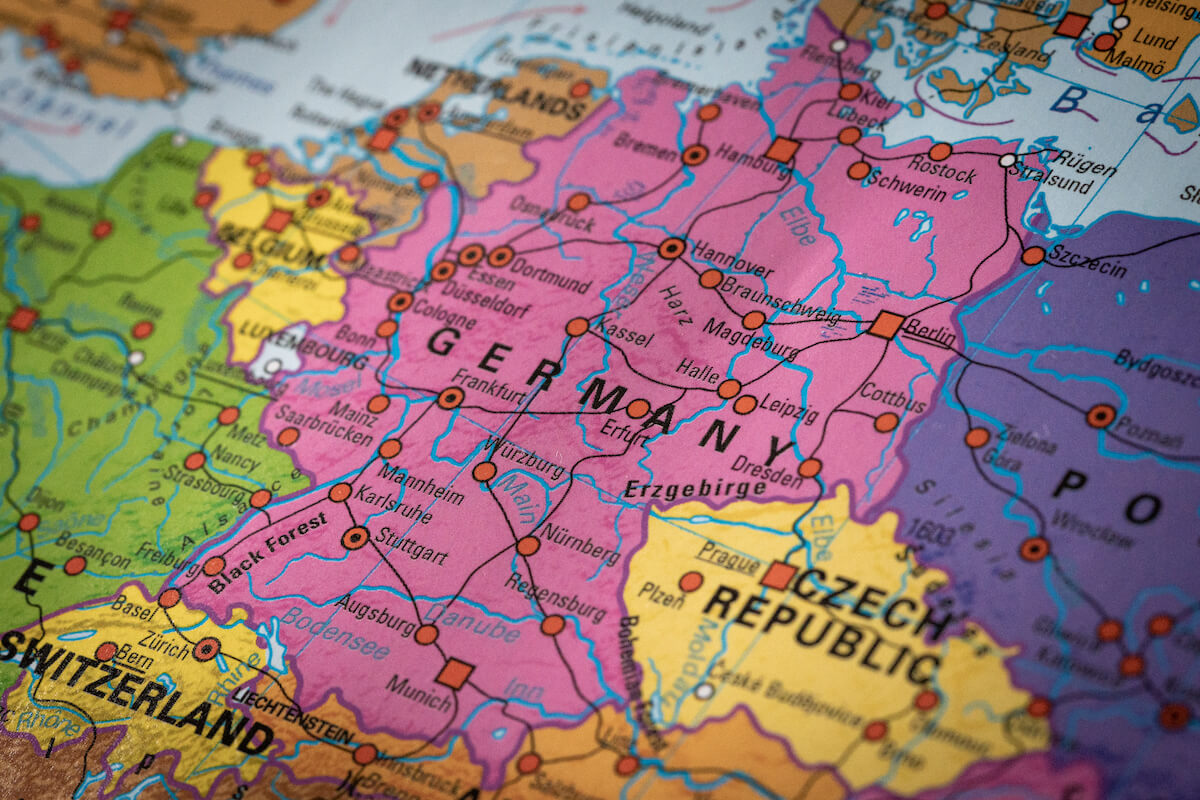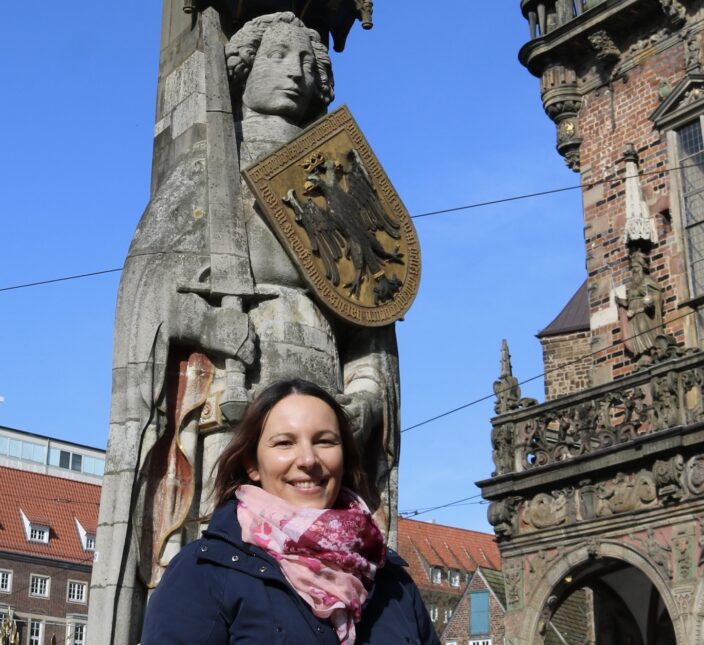Are you planning to visit your ancestor’s hometown on your ancestry-inspired trip to Germany? If so, make sure you read this first! Buckle up, because we’re about to embark on a rollercoaster ride through the mishaps and misadventures of a poorly planned ancestry trip to a German hometown. This is exactly how NOT to do it. But don’t worry: After every mistake, I will also tell you how not to fail your ancestral hometown visit.
Meet Emma
Today I have a little story for you. The story of an ancestral traveler from the USA. Let’s call her Emma Schmidt. On her first ever ancestry trip to Germany, Emma wants to learn more about her German ancestors who were named “Schmidt” (one of the most common surnames in Germany, by the way!).
While on her 10-day trip to Germany, she sets aside one day to visit her ancestral German hometown. Through ancestry research, she has found out about the small village where her Schmidt ancestors were from. So she books herself a hotel in the next bigger city nearby and looks forward to her ancestry trip the next day.
Unfortunately, not everything on Emma’s German hometown visit goes according to plan (or no plan at all in Emma’s case). She makes the 7 most common ancestry trip mistakes.
Let’s take a look and learn from her mistakes, so you can avoid them on your very own ancestry-inspired trip to Germany.

Disclaimer:
Any names, characters, places, or events mentioned in this story are fictional. Any resemblance to real individuals, living or dead, or to actual events is purely coincidental. However, all 7 mistakes mentioned in this story are actually true experiences. They were told to me by either guests on my tours or interviewees for my Master thesis about ancestral travel to Germany.

1. Mistake: The Train That Never Was
(not informing yourself how to get to your German hometown)
Emma envisioned a scenic train ride on her ancestry trip to her small ancestral village. But nope, Germany had other plans. When she checks out Google Maps on the day of her hometown visit, she realizes that her very small German hometown called “Glockenbach” is only accessible by a magical unicorn or a rental car. Sadly, Emma has neither of these two modes of transport available to her.

How to avoid Emma’s mistake:
Instead of relying on Google Maps at the last minute, Emma could have researched transportation options in advance – ideally while she was still at home in the US. By doing so, she would have discovered that Glockenbach is only accessible by car.
She could have booked an (automatic!) rental car online from home or explored alternative routes, such as nearby train stations with bus connections. If she had connected with people in the region, such as hobby genealogists or local guides via email, they may have been able to pick her up from the nearest train station.
Generally speaking, the train system in Germany is quite large and well-connected. It’s true that very small villages usually do not have their own train station. But there is often one nearby that is not too far away. In any case, this advance preparation would have ensured a smooth arrival in Emma’s German hometown.

2. Mistake: The Stick Shift Saga
(not pre-ordering an automatic rental car)
Still determined to get her ancestral hometown adventure today, Emma finds out about the nearest rental car station and rents a car.
However, she is handed a stick shift at the car rental place. In Germany, stick shifts are more common than automatic cars. And because Emma is renting a car at such short notice, she has to take what’s available. Emma normally drives automatic and is nervous about driving with a stick shift. But, determined to get to her German hometown, she decides to go ahead.
However, when she enters the German Autobahn, the next challenge awaits: She suddenly finds herself in a “Fast & Furious” movie – minus the Vin Diesel charisma. To make things worse, the car display mocks her with kilometers and Celsius, which she doesn’t know how to convert into miles and Fahrenheit.

How to avoid Emma’s mistake:
Instead of renting a car at the last minute, Emma could have pre-ordered an automatic rental car online from home. This would have ensured she had a vehicle she was comfortable driving – avoiding the extra stress of navigating a stick shift on the busy and fast-paced Autobahn.
Additionally, familiarizing herself with the metric system and the conversions beforehand would have made her journey smoother and more enjoyable. For example, Emma could have quite easily remembered the conversion from Fahrenheit to Celsius with the following wish for a 70th birthday: “You are just 70 in Fahrenheit, in Celsius, you are only 21.” 😀

3. Mistake: Tombstone Hide-and-Seek
(assuming that you will find very old graves in Germany)
Emma somehow manages to survive the German Autobahn and finally arrives in her “hometown”. Here, she heads straight to the local graveyard – armed with determination to find the graves of her “Schmidt” ancestors. But the grave is playing “hide-and-seek”. It doesn’t really help that the surname, which derives from the former blacksmith profession (“Smith” in English), is one of the most common surnames in Germany.
Frustration sets in as Emma contemplates the possibility that the Schmidts might have been buried under the wrong tree.
What Emma doesn’t know is many graves in Germany (that the descendants also have to pay an annual fee for by the way) get recycled after around 30-60 years because there isn’t unlimited space on the graveyards. Thus, you usually won’t find very old graves here. Except for really famous people, but not for the “ordinary” folk.

How to avoid Emma’s mistake:
Instead of heading straight to the graveyard, Emma could have contacted the local historical society or church in advance to gather information about her Schmidt ancestors. This would have helped her to locate records that could guide her to the right graves (if they are still there).
Alternatively, these sources could have provided other, insightful information about her German ancestors. With this preparation, Emma’s ancestry trip to her German hometown would have been more successful and less frustrating.

4. Mistake: The Elusive Heimatverein
(not researching local heritage associations and their opening times in advance)
Still determined to find out at least something about her German ancestors on her one-day ancestry trip, Emma continues her stroll through the village. A beautiful, old house catches her attention. Next to the door is a sign saying “Heimathaus” and “Heimatverein”.
Emma doesn’t know a lot of German. But she has heard of the “Heimatverein” and knows that this is the local heritage association. However, it seems to be closed today. Why? Because it’s run by volunteers, and today is not a meeting day. Emma is here on a Wednesday, and there is a sign on the house that there is an event next Saturday. Regrettably, Emma will be back home in America by then.

How to avoid Emma’s mistake:
Because Emma already knew the name of her ancestral hometown, she could have researched the local heritage association’s opening times and events while still at home in the US. Nowadays, this can be easily done by a quick online search.
By doing so, she would have known that the “Heimatverein” was closed on Wednesdays and could have planned her ancestry trip for a day when it was open. She could have also rescheduled her ancestry trip to Saturday, so she is able to attend the event that was happening in the week she was there.
That way, she could have met some of the members of the local heritage society, ask them questions and gather valuable information about her German ancestors.
Extra tip: If Emma would have not found any information for a “Heimatverein” in Glockenbach, she could have still contacted the tourist information or the mayor’s office of her German hometown and/or the wider region. These sources can be contacted just as easily today with just a quick Internet search, a few clicks and one or two emails.

5. Mistake: Lost and (not) found: The Schmidt Descendants
(not researching and contacting anyone who could help to find your living German relatives)
When Emma stands before the “Heimathaus”, she notices a sign: “Ehemals im Besitz des Bäckers Johann Heinrich Schmidt, geboren 8.5.1815, gestorben 9.10.1878 in den USA (Clinton County).” At least, she can translate this with her language app to “Formerly owned by the baker Johann Heinrich Schmidt, born 5/8/1815, died 10/9/1878 in Clinton Country, USA.”
These dates align precisely with Emma’s research on her German ancestor of the same name. This and the fact that he died in the county where Emma is from in the USA can’t be a coincidence! Nearby, another sign lists the modern Schmidt family as active members of the “Heimatverein”.
Unfortunately though, Emma has no clue how to get in touch with them. She looks around, but there is no-one she could ask on a rainy Wednesday morning.
That’s a pity. If Emma had managed to get to know her living German relatives, they could have shown her the old family home, which still exists. The very house, where her ancestors baked bread, debated life’s mysteries and made the final decision to emigrate to America.

How to avoid Emma’s mistake:
Emma could have researched and contacted local heritage associations or genealogical societies in advance. By doing so, she could have arranged to meet members of the Schmidt family or other knowledgeable locals, such as hobby genealogists.
These people could have helped her finding her living German relatives.
This preparation would have allowed Emma to connect with her German relatives, which is often one of the most memorable part of an ancestry trip to Germany. Many ancestral travels notice “family resemblances” in the way their distant relatives look or behave.
Thus, a meeting with them would have made her trip even more memorable and the photos that she took there even more precious.
Emma could have also seen the former family house to uncover some fascinating facts of her German ancestors’ lives – perhaps told to her by her new-found family.

6. Mistake: The Closed Church Chronicles
(not informing yourself about the opening times of your German hometown’s church)
The church – Emma’s last hope for answers – stands before her, locked tighter than a German vault. She imitates “When does it open?” to an elderly passerby, who responds with a friendly smile and a shrug.
Then, her eyes catch a sign on the church, which states “Öffnungszeiten”. Emma assumes that this means “opening times”. She is right. But unfortunately, this also means that the one day she is here – Wednesday – the church is closed. Bummer.

How to avoid Emma’s mistake:
Again, Emma could have researched the church’s opening times via a quick Internet search. By doing so, she would have known that the church was closed on Wednesdays and could have planned her visit for a day when it was open.
Perhaps she would have even found the email address of the priest/pastor or other members of the parish. These people are often very interested in Americans that come to visit and might have welcomed her for a guided tour. They could have shown her some hidden treasures, shared new information they found in the church archives, and explained things like how old the baptismal font is.
This easy-to-do preparation would have allowed Emma to see the church from the inside and potentially find out valuable new information about her ancestors. For example, she could have touched the same baptismal font that her ancestors used to gather at (and probably touched as well).

7. Mistake: The Museum Misfortune
(not researching if there are museums about regional history nearby)
It’s getting late and Emma decides to drive back to her hotel in the city. While driving, she spots a road sign rushing by on the Autobahn. It says “Nächste Ausfahrt Museumsdorf”. Emma understands enough German to figure out that this means “Next exit Open-Air Museum.”
However, it’s 8 pm and the museum surely is closed by now. Oh, the missed opportunity! Had she known, she could have been exploring and entering into the old (farm) houses that have been re-erected here from the whole region.
That way, she could have gotten a really good understanding of what her ancestors’ daily lives would have been like.
Emma is left with a sigh and a mental note: “Next time, I research my ancestry trip better!”

How to avoid Emma’s mistake:
Instead of missing the opportunity, Emma could have researched nearby sights of interests and their opening times in advance from home. For example, open-air museums or other regional museums.
This would have allowed her to plan a visit to the open-air museum during its operating hours, giving her a chance to immerse herself in the regional history and gain a deeper understanding of her ancestors’ daily lives.
Again: With just a little bit of advance preparation, Emma’s visit to her German ancestral hometown would have been much more enriching and meaningful.

Epilogue: Lessons learned (the hard way)
Back at the hotel, a frustrated Emma sinks into her hotel sheets. “Nevermind”, she says to herself, “at least I saw where my ancestors came from. And that’s good enough for now.”
Sure, just seeing your ancestral German hometown is an experience in itself. But with just a little bit more advance planning of her trip, Emma’s ancestry trip to her German hometown could have been “great” instead of just “good”. She could have literally “walked in her ancestors’ footsteps”.

To sum up: What could have been…
On her ancestry trip to Germany, Emma could have…
1. … stepped into her ancestral church and touched the very baptismal font her ancestors used to gather at (and probably touched as well).
2. … met her living Schmidt relatives, who could have taken her inside the still existing farm house of her Schmidt ancestors and tell her stories of their common forebears. They also could have taken her to the houses and farms of her other German ancestors because many of these still exist in the surrounding countryside.
3. … heard more historical background of the times her German ancestors lived through by the local (volunteer) guides at the Heimatverein. These “hobby genealogists” could have even tracked down other lines of her German family through research in the church books and local archives.
4. … seen the “Heimathaus”, which coincidently was her ancestor’s home, from the inside. There, she would have felt like she really stepped back in time.
5. … and got a real feel of what her German ancestors’ daily lives were like by stepping inside houses from the 18th and 19th centuries in the nearby open-air museum. If only she had known that there was a so-called “living history museum”.

All of this is, by the way, what our previous tour participants did. You can read more about their fun ancestral experiences in Germany in the Testimonials section.
However, Emma will fly back home to the US tomorrow. So there is no time to come back on Thursday. At this point, Emma also doesn’t know if she will ever come back to Germany to find out more about her German roots.
How NOT to fail your ancestry trip to your German hometown
1. Do you want to avoid all the mistakes that Emma has made and instead make the most of your ancestry trip to Germany?
2. Do you want to “literally walk in your ancestors’ footsteps”?
3. Learn everything you can about their daily lives, the time periods they lived through, and their reasons for emigrating?
4. Do you want to meet your living relatives, notice any family resemblances, and make new friends for life?
5. And do you want to make lifelong travel memories that you can share with friends and family back home and pass down to the following generations?
If your answers to at least one of these questions is yes, it’s time to join our non-binding waiting list, so you will be among the first to be notified when the next Germany Trip Planning MASTERCLASS opens.

Photos in this blog post: Envato Elements and Sonja Irani | MyAncestorsJourney.com
Coming soon: The Germany Trip Planning MASTERCLASS
Are you planning an ancestry trip to Germany to find out more about your German ancestors, but don’t want to do it alone?
Then you don’t want to miss our upcoming Germany Trip Planning MASTERCLASS, which will open for the next enrollment in the early February 2026!
The Germany Trip Planning MASTERCLASS “Revisit Germany” is a self-learn online course with monthly live calls via Zoom and a private Facebook group for all course participants. It is designed to plan your complete trip itinerary within 6 weeks, but you will access to the course for 12 months.
But, the online course only opens its doors for a few days. If you join the non-binding waiting list, you will get an email reminder when the course opens for enrollment.
Don’t miss the opening date and your exclusive waiting list discount!


